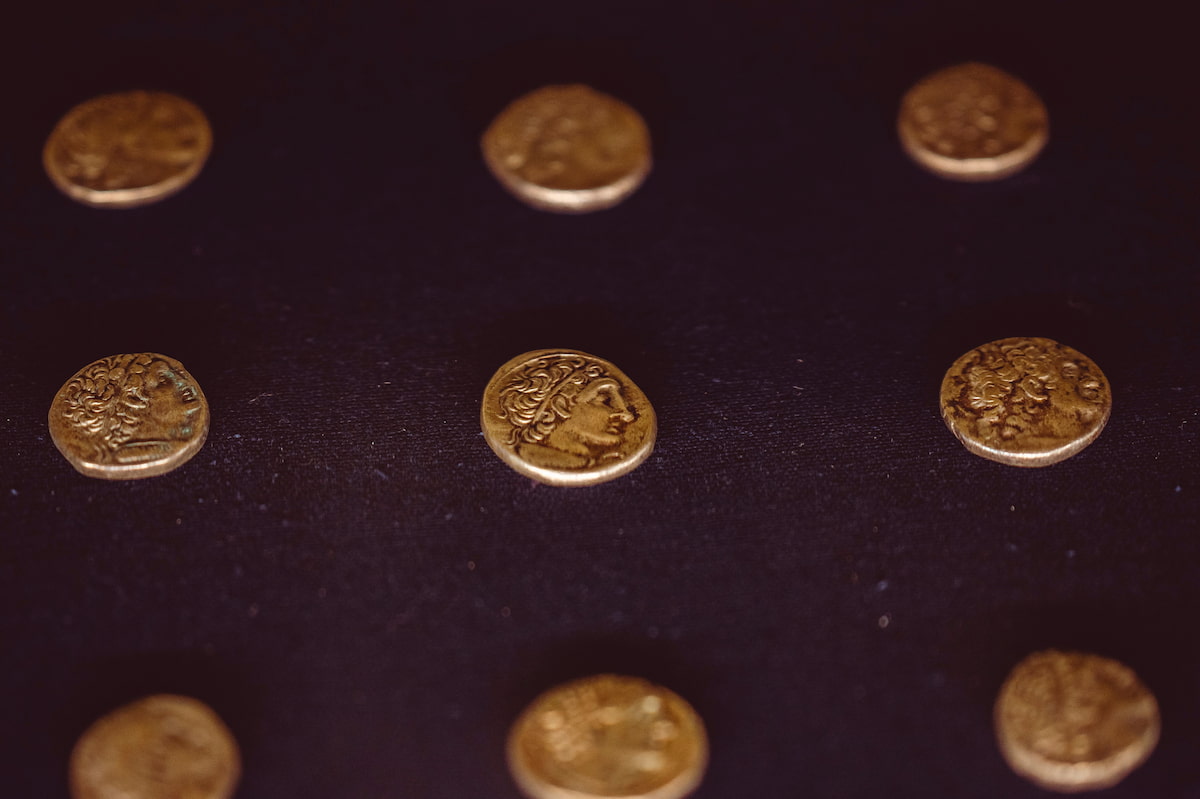Currency In Ancient Egypt and Egypt Money Usage Through The History
During the early ages of Egypt, the ancient Egyptians coins were not created yet. They used barter system. Then the ancient Egyptians started introducing different coins over the years . Moreover, there are developments in the Egypt ancient currency up till now. Lets go deeper to know about the ancient Egyptian currency, money symbols Also, Egypt ancient currency value, and when were coins created.
Barter System In Ancient Egypt
Before the appearence of currencies, Egyptian civilization depended on the barter system. As they exchanged goods such as grain, eggs, livestock, and handicrafts.
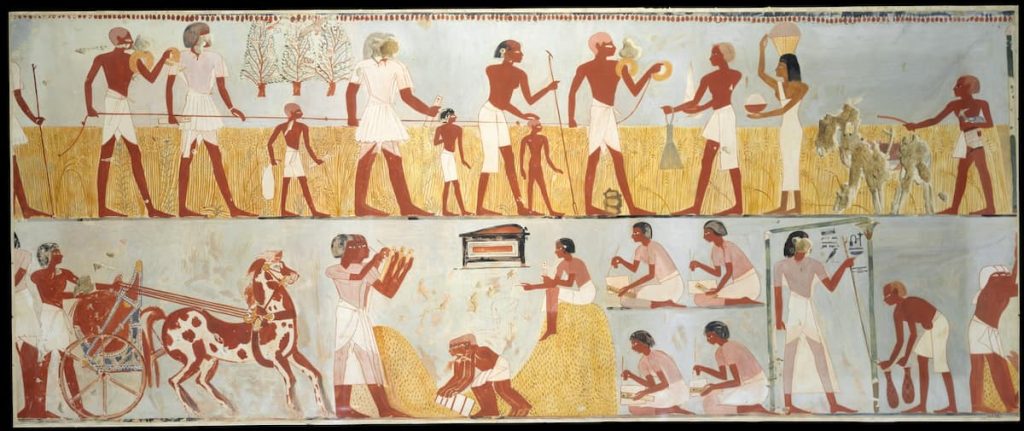
Barter and trading system in ancient Egypt
Ancient civilizations used to deal with the barter system of goods. Each civilization according to what distinguished it and the wealth it had. The ancient Egyptian civilization used wheat and livestock. India used coffee, and China used rice, and so on, in comparison to the rest of the civilizations
They sometimes used Checks instead of direct payment during barter. These checks and contracts varied between sales and purchase contracts, taxes, and property contracts.
Units Of Measurement and Ancient Egyptian Money Symbols
They used instead a system based on measuring the weight of precious metals such as gold and silver, known as the “deben.” They also used other units of measurement such as the “sha’at” and the “kite.”
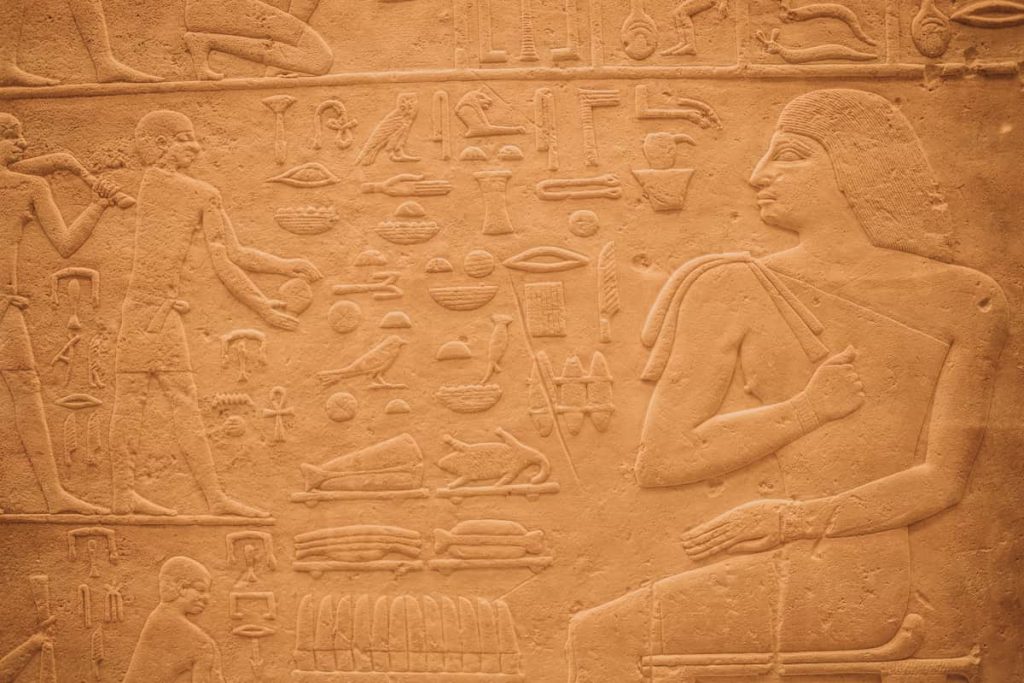
Using the Units Of Measurement intron of an Ancient Egyptian noble
Deben:
The “deben” was a unit of measurement . they used it to estimate the value of precious metals, such as copper, silver, and gold, and was approximately 93.3 grams. Also, it was used as an ancient Egyptian money symbol.
Sheat:
Sheet was another unit and an ancient Egyptian money symbol of measurement which has sparked debate between scientists about its nature.
Kite:
The “kite” was a smaller unit of measurement than the deben and they used it to determine the Egypt ancient currency value of gold and silver.
The Usage Of Metals In Coins
The Pharaohs knew well the value of metals and depended on metals such as gold, silver, copper, and iron to manufacture coins.
They measured the value of goods by the weight of coins and put a stamp on coins to indicate their value.
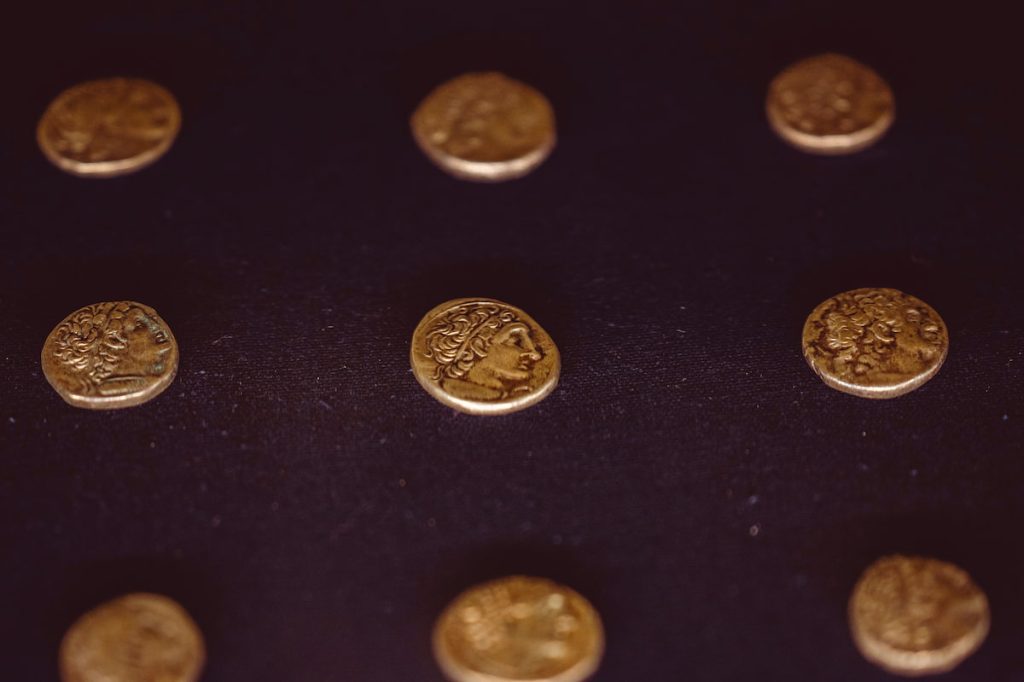
Usage pf Metal in ancient coins
As civilizations developed, individuals became familiar with the differences in value between metals such as copper, tin, iron, gold, and silver. They began to exchange pieces of these metals for wheat and other commodities.
Because the value of things relative to each other was not fixed, there was a need to determine the value of consumer products based on metals to avoid unfair treatment to barterers. Metals were used according to their weight, and coins were weighed in advance and stamped with a mark indicating their value. The most prominent example of this was the “attestation” system in ancient Egtian and Roman law.
Copper and bronze coins were in the form of bars, sheets, and rings. Their names were from units of weight such as the pound, the livre, and the mark.
When they needed to exchange for large transactions, they turned to precious metals such as gold and silver, which were in temples. They used these metals in exchange and called them precious metals.
The Beginning of Coins
Over the history, Egyptians have been pioneers in different fields of knowledge, such as medicine, astronomy, industry, and even economics. Ancient Egyptians recognized the importance of an alternative system to barter. this was the birth of Egyptian money and Egypt ancient currency.It was as an alternative to barter with the development of political life. The first coin minted, was called “Nubnefer.”
Nub Nefer
This was the first ancient Egyptian coin, that appeared in 350 BC in the name of Pharaoh Tachos. It means “good or pure gold.” It is an extremely rare Egyptian coin, as there are just twenty coins in the world uptill now. This coin contains ancient pharaonic inscriptions. They used primarily this Egypt ancient currency to pay the wages of Greek mercenaries brought by the Egyptian government to fight the Persians. This coin was not circulated among the general public.
Other Currencies and Coins In Ancient Egypt
1- Pharaonic coinage of the god Khepri:
The pharaohs drew images of their gods on coins, including the god Khepri They drew him as a scarab or dung beetle, it was just in coins.
2- Pharaonic coinage of the ram:
They inserted a gold coin with the symbol of the ram. It represented the main sun god Amun-Ra or the creator god Khnum.
3- Cleopatra’s Pharaonic Coins:
Cleopatra introduced bronze coins with her image. One side of the coin had her image, while the other had an image of an eagle on a lightning bolt.
The Evolution of Currency
During the reign of Alexander the Great. Egyptians used coins for the first time in their daily transactions. It contained the image of Alexander.
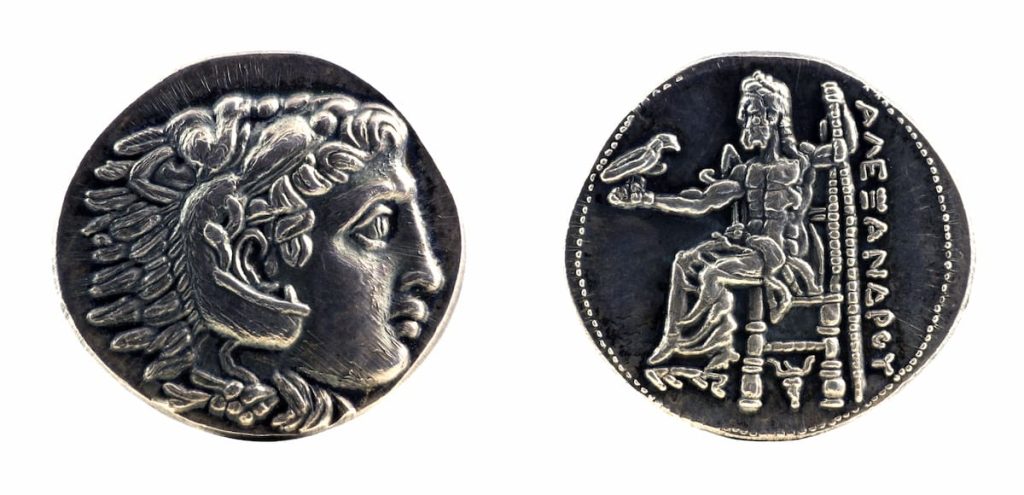
Silver coin with Alexander the Great
Roman Coins in Ancient Egypt
In 306 BC, they made the first independent Egyptian coins in gold, silver, and bronze.
Egypt ancient currency value at this time depended on the material. So, gold was more precious. Later, coins continued during the Roman and Byzantine eras. It contained the image of the ruling king on one side and the image of the patron god on the other.
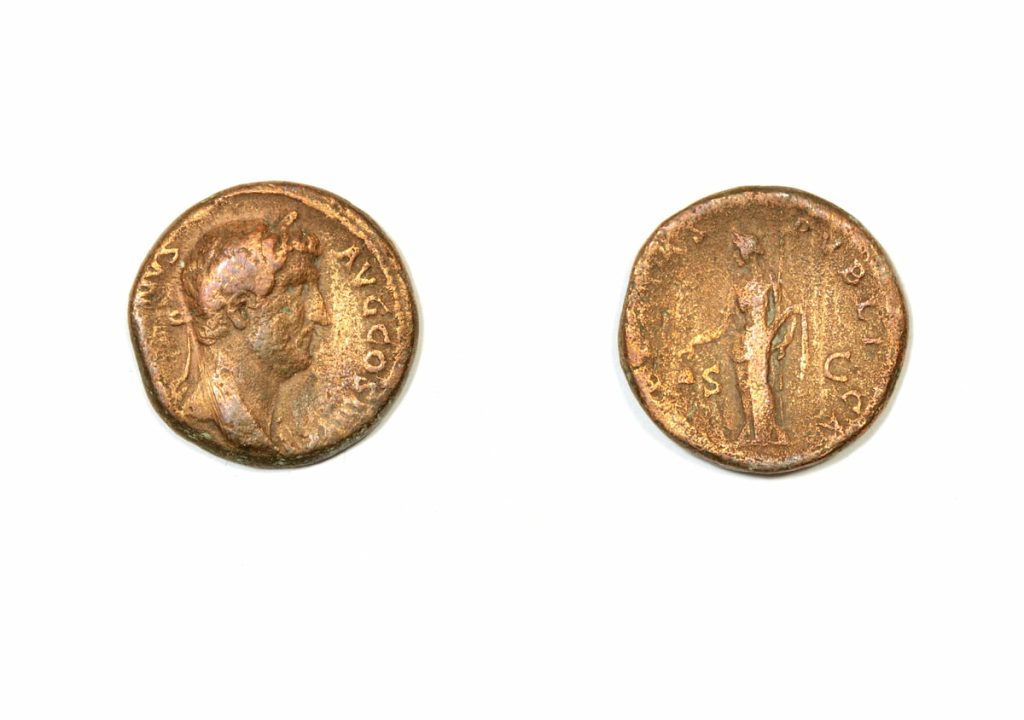
Ancient Roman Golden Coin
Egyptian Currency and Value During ancient Islamic Civilization
Money had a special form in Islamic civilization. Caliph Omar bin Al-Khattab ordered the minting of dirhams like those used in Persia in the year 18 AH. They had a name as( Khosravi dirhams). Actually he was the first to mint coins in Islam.
During the caliphate of Uthman ibn Affan, they minted dirhams with the inscription “God is Great.” Muawiyah ibn Abi Sufyan then minted dirhams in 41 AH and dinars with his image engraved on them, girdled with his sword.
In 65 AH, Abd al-Malik ibn Marwan focused on currency reform. He formed a committee to examine weights and measures. He ordered the minting of new dirhams and dinars called “Samiriya” and prohibited the use of Roman coins. The fils denomination was in 750 AD. They wrote “In the name of God, there is no god but God alone,” on one side and wrote “Muhammad is the Messenger of God on the other side. They also wrote Around the circle( This fils was in Egypt in the year 133 AH).
Throughout civilizations until the Ayyubid state, currencies retained their known value, with only a change in shape. This continued until the arrival of the Ottoman state in Egypt and the issuance of the ‘beloved zir’ currency.”
Egyptian Currencies in Muhammad Ali’s Reign
During the reign of Muhammad Ali. He focused on economic reform,and issued a decision to consider the (Riyal) that was of silver as the unit of currency, with a value of 20 piasters. He then approved the 100 piaster Egyptian pound of pure gold as the currency used in large transactions. Then he had determined the value of foreign currencies in Egypt.
In 1899, the National Bank of Egypt issued banknotes for the first time. It also issued the paper pound, whose value was equal to 7.4 grams of gold. They used This standard between 1885 and the outbreak of World War I in 1914, when the Egyptian pound was linked to the British pound, and the British pound was equal to 0.9 Egyptian pounds.
Khedive Ismail issued copper coins containing the name of Sultan Abdul Aziz bin Mahmoud Khan Ezz Nasra. Khedive Tawfiq then decided that the Egyptian pound would be the unit of currency. He also divided it into its lowest denomination, the quarter piaster.
In 1922, a gold coin was minted in London in the name of King Fuad. It contained his image in royal attire on one-pound and five-pound coins, and the inscription “Fuad I, King of Egypt.” In 1924, nickel coins in denominations of two milliemes, five milliemes, and ten milliemes, as well as a bronze half-millieme, were in Egypt.
In 1937, there were silver coins of 20, 10, five piasters, and two piasters at the London Mint in the name of King Farouk I. There is”Farouk I, King of Egypt,” with his image on one side and “The Kingdom of Egypt”, 1937 AD on the other side.
Conclusion
The development of Egypt ancient currency in Egypt passed by many stages. The most important stage was how Egypt ancient currency value was evaluated according to the material it was made out from. Also, how ancient Egyptian money symbols was created. The usage of ancient Egypt coins at the late period. This all indicats how Egypt was one of the countries to use coins and money symbols, this indicate how Egypt is a great country and its history is great and worth reading about.

